“The stars that Sirius and Orion boast
In deepest night to human ken are lost”
Phenomena by Aratus
In this article I want to show a few tricks that can be used to locate various stars or constellations using the stars from the constellation Orion. Orion is useful as a reference constellation because it has many stars with an apparent magnitude under 3 ( which means they are very bright), it is fully visible at latitudes between 79º N and 67º S (pretty much the inhabitable range), it is a big constellation and it is easy to identify it in the sky. We will also see that Orion is in the neighborhood of very important stars or constellations.
When you look in the astronomy books, the constellations are usually shown as asterisms or patterns where various stars are connected by lines. These asterism patterns look like stick figures. Unfortunately, you will see that sometimes the astronomy books show a slightly different pattern or stick figure for the same constellation. Another problem is that some stars from a constellation are too dim to be seen with the naked eye (especially if you live in a city). In this guide I will focus on how to find the brightest stars from various constellations. After you find the brightest star or stars from the constellation, you can use these stars as reference to create the constellation pattern.
Orion
Before we find stars from other constellations using Orion, we must know how to identify Orion. In Figure 1, we can see the general neighborhood of Orion as seen from my location in the Northern hemisphere. We can see that Orion is under the ecliptic line (path of the Sun), and like the Sun it will usually have a Southern direction. If you are in the Southern hemisphere, Orion will be upside down, above the ecliptic and it will usually have a Northern direction.
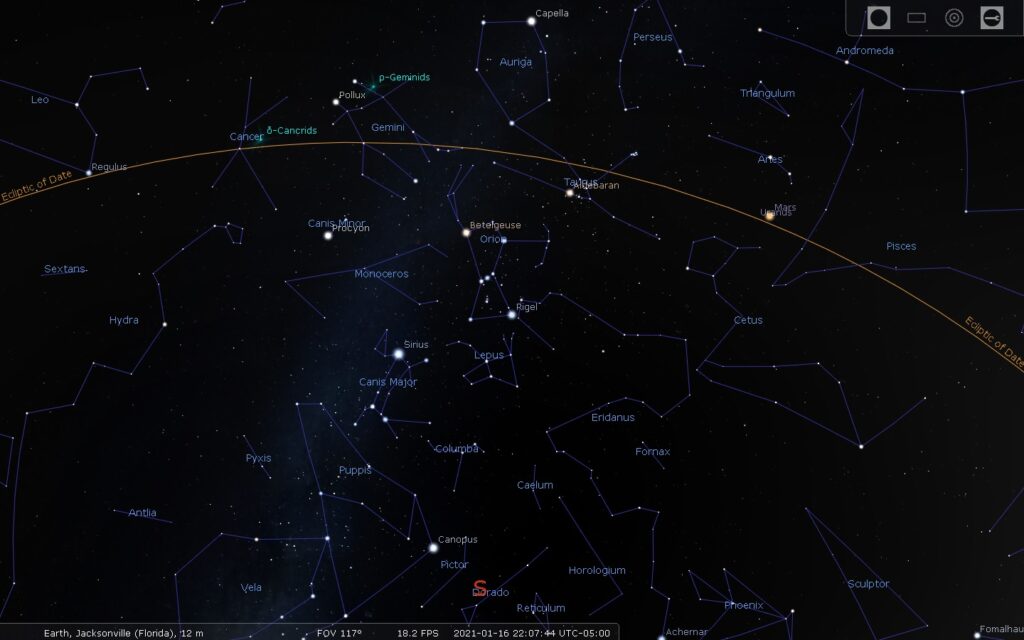
The constellation Orion has about 8 stars that are very bright. Betelgeuse and Bellatrix seem to be the 2 armpits of Orion (Figure 2). Alnitak, Alnilam and Mintaka form Orion’s Belt. Under Orion’s Belt you can see the star Hatysa. Near Hatysa, there is the Trapezium Cluster and the Great Orion Nebula. Hatysa, the Trapezium Cluster and the Great Orion Nebula form Orion’s Sword or Orion’s Dagger. Finally, the stars Saiph and Rigel are the 2 legs of the constellation. The pattern made by Betelgeuse, Bellatrix, Orion’s Belt, Saiph and Rigel looks like a butterfly.
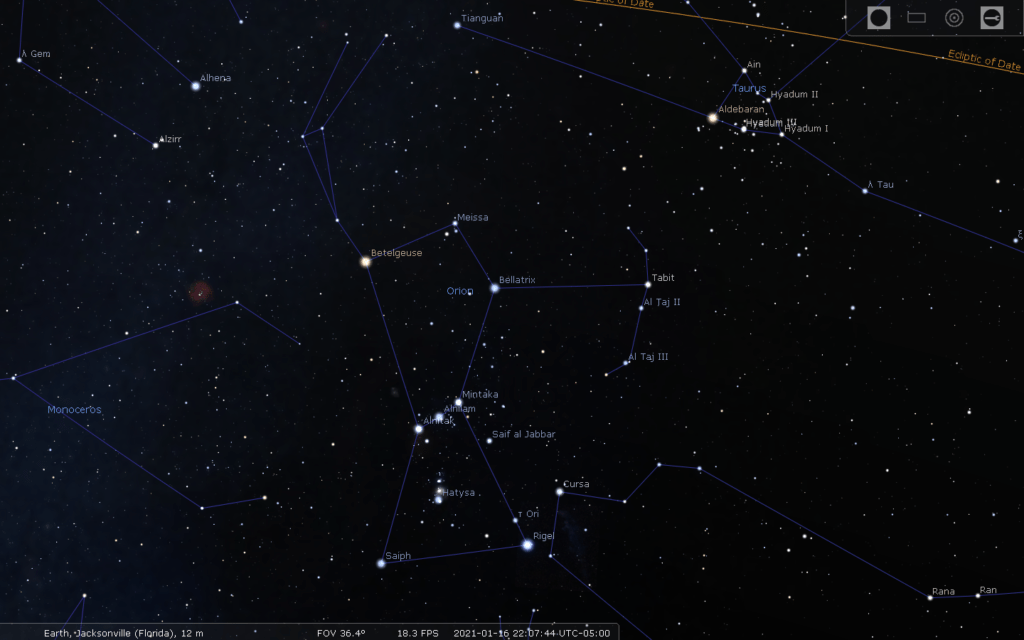
Beginners should know that the astronomical reference materials sometimes use the Arabic or Greek names for the stars and sometimes they use the Bayer designation. The Bayer designation names a star using a Greek letter and the genitive form of the constellation it belongs (the names of the constellations are in Latin). For example, Betelgeuse is also known as Alpha Orionis (alpha of Orion). Usually the stars are named according to their brightness, using the standard Greek alphabet. Thus, alpha should be the brightest star, beta the second brightest star and so on. Unfortunately, you will find out that sometimes the beta star or even the gamma star is actually the brightest star in the constellation. Rigel is also called Beta Orionis, but it is usually the brightest star in Orion. Betelgeuse is a variable star, and sometimes it will be brighter than Rigel. More confusion is added by the fact that sometimes the same star has more than one Arabic name and sometimes one of its names is shared by another star.
Orion’s Belt, Sirius, and Taurus
One of the most well know tricks is to use Orion’s Belt in order to find the star Sirius from the constellation Canis Major. In Figure 3 you can see that if you draw a line through Orion’s Belt and extend it beyond Alnitak, the line will pass very close to Sirius. Sirius is a very important star since it is the brightest star seen from Earth (besides the Sun).
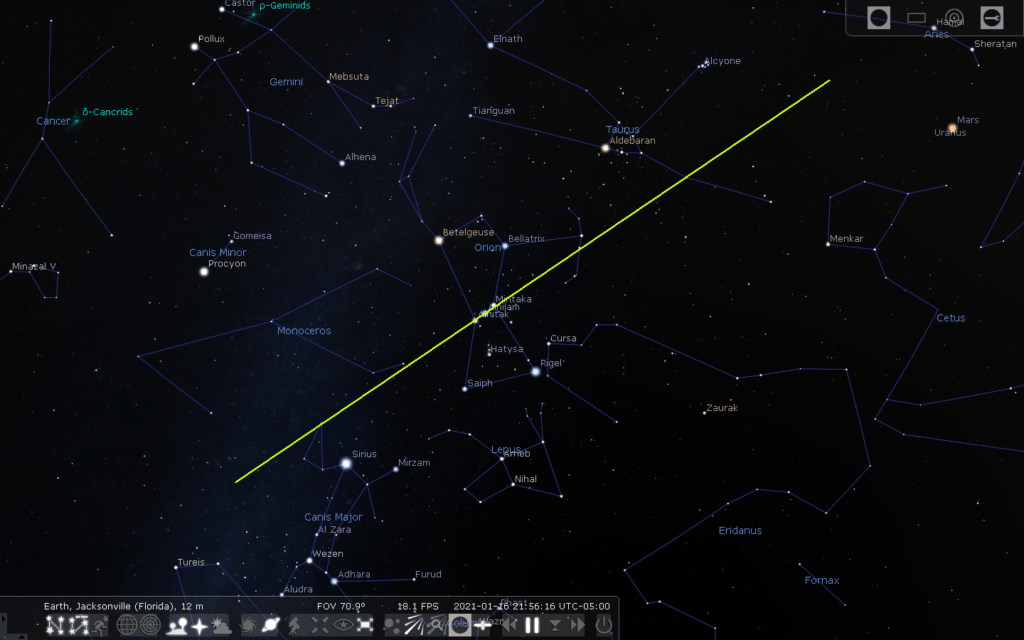
If we look in the opposite direction, beyond Mintaka, the line will through the Taurus constellation. When you are in the field and follow the line in this direction, you will immediately know which star is Aldebaran, since it is by far the brightest star in Taurus. Closer to the line and just below Aldebaran, is the Hyades Cluster, which is not labeled in Figure 3. In Figure 3 you can also see that the line passes very close to the Pleiades Cluster, with Alcyone being the brightest star from the cluster.
Gemini and the Rigel-Betelgeuse axis
The brightest stars from the constellation Gemini are Castor and Pollux. The stars are close to each other and they represent the heads of the 2 mythological brothers. The easiest way to find the pair is to draw an imaginary line that goes from Rigel and extends beyond Betelgeuse. In Figure 4, you can see that the line passes very close to Castor. You can also see that the line passes very close to Alhena, which is the 3rd brightest star in Gemini.
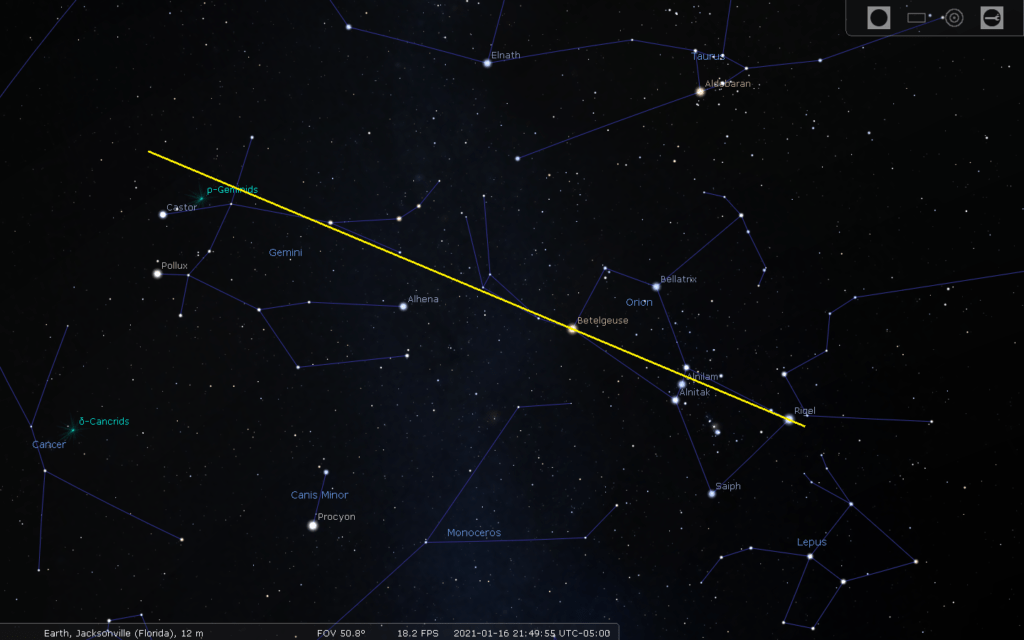
Leo, Canis Minor, Cancer and the Bellatrix-Betelgeuse Axis
The brightest star from the constellation Leo is Regulus. The easiest way to find Regulus is to draw an imaginary line that goes from Bellatrix and extends beyond Betelgeuse. In Figure 5, you can see that this extended line passes very close to Regulus. Once you know where Regulus is, you can use it as a reference to find other important stars from Leo.
You can see that the same line also passes very close to the constellation Canis Minor, which has only 2 stars. The star Procyon is easy to spot since it is brighter than Betelgeuse. The star closer to the line but not labeled in the image is Gomeisa, which has an apparent magnitude under 3. Thus, both stars should be visible.
The line also passes near the brightest stars from the constellation Cancer. All the stars that belong to Cancer have an apparent magnitude well above 3, so they are dim especially if you are in an urban area.
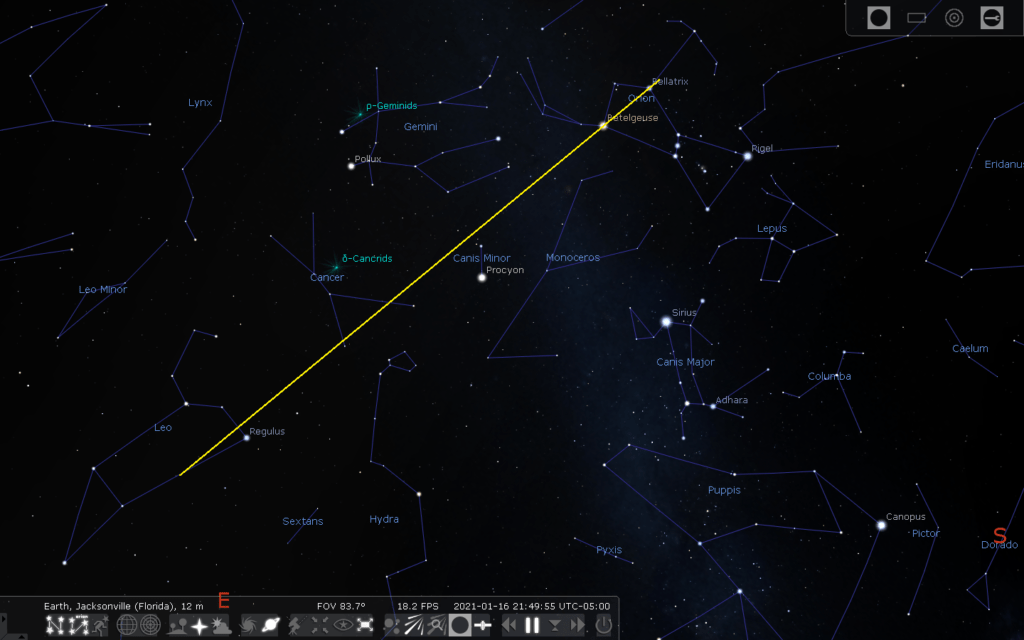
Some Recommendations
Before I finish this article, I want to make a few useful recommendations. There are a few useful free tools that can help beginners learn about the sky. The first tool is the Stellarium planetarium app. You can use Stellarium to simulate the movement of the sky for your location in real time. Stellarium allows you to click on stars and other sky objects in order to get real time data on their apparent magnitude, position, color index etc. If you want to download Stellarium on your computer, go here. You can also download Stellarium on Google Play and App Store. Sky Map is another useful app that I have used.
If you want to buy a book you can buy “Atlas of the Constellations” by Giles Sparrow. The book has useful information about all the 88 constellations, including the time of the year when a constellation is most visible or the range of latitudes where the constellation is fully visible. The book can be useful when you are in the field stargazing.
Addendum: You can find part 2 at this link.

1 comment